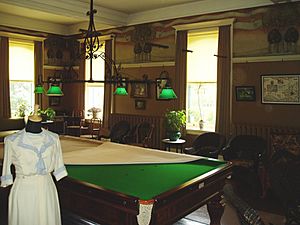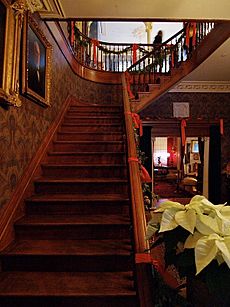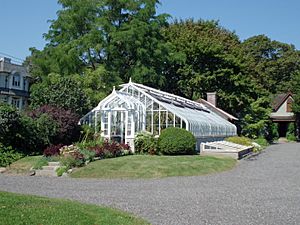Spadina House facts for kids
Quick facts for kids Spadina Museum |
|
|---|---|

View toward the front entrance in 2021
|
|
| General information | |
| Type | Mansion |
| Location | 285 Spadina Road Toronto, Ontario, Canada |
| Coordinates | 43°40′44″N 79°24′29″W / 43.679023°N 79.40815°W |
| Current tenants | Historic house museum (since 1984) |
| Construction started | 1866 |
| Client | James Austin |
| Owner | City of Toronto and Ontario Heritage Trust |
| Design and construction | |
| Architect | Vaux Chadwick (1896) Eustace Bird (1905–1912) |
| Designated: | July 26, 2019 |
| Designated: | March 31, 1976 |
Spadina Museum (pronounced spa-DEE-na), also known as Spadina House, is a historic mansion in Toronto, Ontario. It's now a historic house museum run by the City of Toronto. The museum keeps the house looking much like it did in the past. It shows how people lived from the 1860s to the 1930s.
The house was closed for a year for big updates. When it reopened on October 24, 2010, it was decorated to look like the 1920s and 1930s. The beautiful gardens around the house also show how they looked when the Austin family lived there.
Contents
History of Spadina House
The very first house on this spot was built in 1818 by Dr. William Warren Baldwin. He called his 200-acre property "Spadina." This name comes from the Ojibwe word espadinong, which means "hill" or "sudden rise of land." The house is located at the top of a hill. Dr. Baldwin designed the two-story wooden house himself.
Sadly, the house burned down in 1835. Since it was a long 5-kilometer walk from the estate to York (which is now Toronto), Dr. Baldwin moved to a house on Front Street. He built a smaller country home on the Spadina property in 1836.
The Austin Family Era
In 1866, James Austin bought the property. He was the person who started The Dominion Bank and Consumers Gas. By this time, some parts of the land had been sold. What Austin bought was about 80 acres. In the late 1800s and early 1900s, this area was the richest part of Toronto. Many of Toronto's most important families had large estates here.
James Austin sold off 40 acres of land west of Spadina Road in 1889. In 1892, he gave the house and 20 acres of the property to his son, Albert William Austin. Albert Austin made the house much bigger with several updates. He even added a third floor in 1912. He sold a lot of the property to the City of Toronto in 1913. This land was used to build the St. Clair Reservoir. Albert Austin passed away in 1933.
The last family member to live in the house was Anna Kathleen Thompson. She was Albert Austin's daughter and lived there from 1942 until 1982. The old house needed a lot of repairs, including new wiring. It would have been very expensive to fix. Instead of selling it to private buyers, the family decided to give the house and all its furniture to the city. In 1984, it opened as a museum. It is now owned by both the city and the Ontario Heritage Foundation. The museum is especially famous for its beautiful gardens.
Visiting Spadina Museum
The Spadina historic house and gardens is one of ten museums run by the City of Toronto. When you visit the museum, you can learn what life was like for people in Toronto in the early 1900s. There are tours at certain times each day. These tours explore the politics, economy, and social life of that time. You can also take a "restoration tour" to learn how the museum was brought back to life.
Other fun tours include "It's a Kid's Life" and "Meet the Austins: A Toronto Family in the 1920s and 1930s." Sometimes, during the holidays, the Spadina House even recreates 1930s live radio shows. This lets visitors experience radio just like the Austin family would have in the 1930s.
Spadina Historic House is also a popular place for taking photos, filming movies, and holding weddings or company events.
What Spadina House Looks Like
The house is at the south end of the northern part of Spadina Road. It sits on top of Davenport Hill. This hill was once the shore of an ancient lake called Lake Iroquois. Right next door, on Austin Terrace, is Casa Loma. This huge castle was built in 1911 by Sir Henry Mill Pellatt.
The Austin Home's design is inspired by the Second Empire architectural style. It also has parts of later Victorian and Edwardian styles. Outside, you'll see bay windows, a brick and stone terrace, brick chimneys, and stone carvings of plants. The oldest building on the property is a wooden stable from the mid-1800s. It was once used as a gardener's shed.
Inside the house, you can see Victorian and Edwardian features. These include a grand staircase in the main hall, tall baseboards, fancy ceiling decorations, and hardwood floors. The home has 14 rooms and six common areas. Many new art pieces and decorations are displayed throughout.
Recent Renovations and Features
The updates in 2010 added special copies of the Austin family's original items. The wallpaper, kitchen, bathroom, and bedroom closet were all redone. Stuffed wolves, found in the family's old records, are now at the museum's entrance. Also, a statue of a woman from France was added. Because of its blue and pink colors, the museum staff nicknamed it "Wonder Woman."
Another cool part of the renovation was adding a special mechanical chair. Albert Austin used this chair when he had trouble moving around. The whole chair moves, and it's kept as an artifact because he designed it for himself. The City of Toronto spent about $600,000 to update Spadina House.
The natural land around Spadina House is protected by law. This estate originally had 200 acres of farmland. There were 200 feet of trees between the house and the edge of the hill to the south. This still gives a clear view of Downtown Toronto and Lake Iroquois. Spadina House's landscape includes formal gardens, an old orchard, a stone pergola, and stone walls. Today, there are 6 acres of restored gardens from 1905. These gardens have more than 300 types of flowers and vegetables.
The name "Spadina House" comes from the Ojibway word "Espadinong," meaning "Hill." Dr. Baldwin chose this name for his home and the street. Many people in Toronto say "Spadina Road" with the "i" like in "mine." But they say "Spadina House" with the "i" like in "ski." Sometimes, "Spadina Road" is said the second way too. However, south of Bloor Street, Spadina Road becomes Spadina Avenue, which is always pronounced with the "i" like in "mine."
Awards and Recognition
Spadina Museum and the Ontario Heritage Trust won the Peggi Armstrong Public Archaeology Award in 2004.
In 2002, Spadina Museum also won the Ontario Museum Association Award of Merit. They won it with Dawn Roach Bowen for their Black History Month program called Meet Mrs. Pipkin. Mrs. Pipkin was a laundress at Spadina House in the 1860s. She came there after escaping slavery in the United States.
Spadina Museum was nominated for the 2013 Toronto Heritage Award. This was in the William Greer Architectural Conservation and Craftsmanship category. This award honors owners who have restored old buildings or structures. The judges look at many things. They check if the restored building meets modern needs, used the right materials, kept much of its original design, and shows good craftsmanship.
See also
 In Spanish: Casa Spadina para niños
In Spanish: Casa Spadina para niños
- List of museums in Toronto
- Mary Lake Augustinian Monastery




